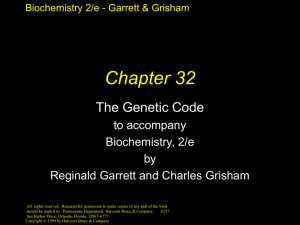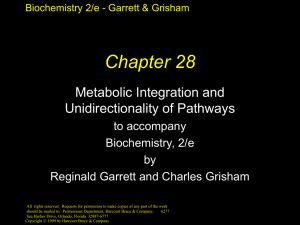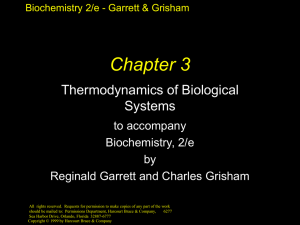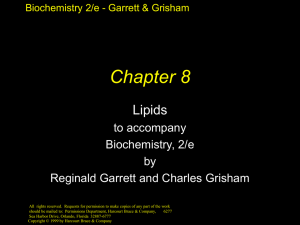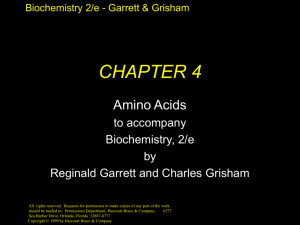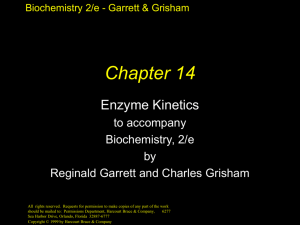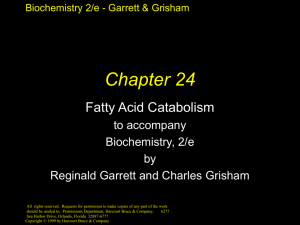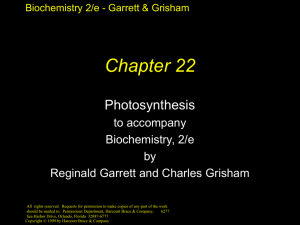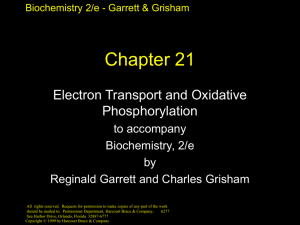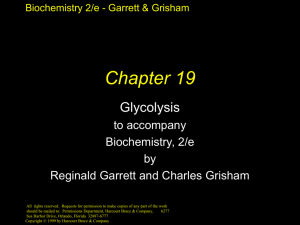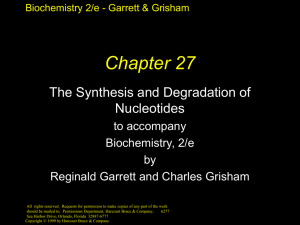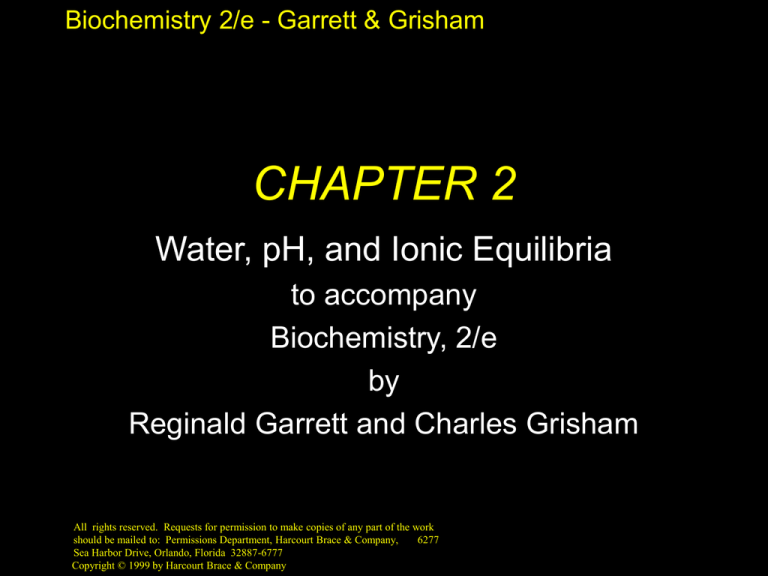
Biochemistry 2/e - Garrett & Grisham
CHAPTER 2
Water, pH, and Ionic Equilibria
to accompany
Biochemistry, 2/e
by
Reginald Garrett and Charles Grisham
All rights reserved. Requests for permission to make copies of any part of the work
should be mailed to: Permissions Department, Harcourt Brace & Company,
6277
Sea Harbor Drive, Orlando, Florida 32887-6777
Copyright © 1999 by Harcourt Brace & Company
Biochemistry 2/e - Garrett & Grisham
Outline
•
•
•
•
2.1 Properties of Water
2.2 pH
2.3 Buffers
2.4 Water's Unique Role in the Fitness
of the Environment
Copyright © 1999 by Harcourt Brace & Company
Biochemistry 2/e - Garrett & Grisham
Properties of Water
• High b.p., m.p., heat of vaporization,
surface tension
• Bent structure makes it polar
• Non-tetrahedral bond angles
• H-bond donor and acceptor
• Potential to form four H-bonds per water
Copyright © 1999 by Harcourt Brace & Company
Biochemistry 2/e - Garrett & Grisham
Copyright © 1999 by Harcourt Brace & Company
Biochemistry 2/e - Garrett & Grisham
Comparison of Ice and Water
•
•
•
•
•
•
Issues: H-bonds and Motion
Ice: 4 H-bonds per water molecule
Water: 2.3 H-bonds per water molecule
Ice: H-bond lifetime - about 10 microsec
Water: H-bond lifetime - about 10 psec
(10 psec = 0.00000000001 sec)
Thats "one times ten to the minus
eleven second"!
Copyright © 1999 by Harcourt Brace & Company
Biochemistry 2/e - Garrett & Grisham
Copyright © 1999 by Harcourt Brace & Company
Biochemistry 2/e - Garrett & Grisham
Copyright © 1999 by Harcourt Brace & Company
Biochemistry 2/e - Garrett & Grisham
Solvent Properties of Water
• Ions are always hydrated in water and
carry around a "hydration shell"
• Water forms H-bonds with polar solutes
• Hydrophobic interactions - a "secret of
life"
Copyright © 1999 by Harcourt Brace & Company
Biochemistry 2/e - Garrett & Grisham
Copyright © 1999 by Harcourt Brace & Company
Biochemistry 2/e - Garrett & Grisham
Hydrophobic Interactions
• A nonpolar solute "organizes" water
• The H-bond network of water
reorganizes to accommodate the
nonpolar solute
• This is an increase in "order" of water
• This is a decrease in ENTROPY
Copyright © 1999 by Harcourt Brace & Company
Biochemistry 2/e - Garrett & Grisham
Copyright © 1999 by Harcourt Brace & Company
Biochemistry 2/e - Garrett & Grisham
Amphiphilic Molecules
Also called "amphipathic"
• Refers to molecules that contain both
polar and nonpolar groups
• Equivalently - to molecules that are
attracted to both polar and nonpolar
environments
• Good examples - fatty acids
Copyright © 1999 by Harcourt Brace & Company
Biochemistry 2/e - Garrett & Grisham
Copyright © 1999 by Harcourt Brace & Company
Biochemistry 2/e - Garrett & Grisham
Copyright © 1999 by Harcourt Brace & Company
Biochemistry 2/e - Garrett & Grisham
Copyright © 1999 by Harcourt Brace & Company
Biochemistry 2/e - Garrett & Grisham
Acid-base Equilibria
•
•
•
•
•
The pH Scale
A convenient means of writing small
concentrations:
pH = -log10 [H+]
Sørensen (Denmark)
If [H+] = 1 x 10 -7 M
Then pH = 7
Copyright © 1999 by Harcourt Brace & Company
Biochemistry 2/e - Garrett & Grisham
Copyright © 1999 by Harcourt Brace & Company
Biochemistry 2/e - Garrett & Grisham
Copyright © 1999 by Harcourt Brace & Company
Biochemistry 2/e - Garrett & Grisham
Copyright © 1999 by Harcourt Brace & Company
Biochemistry 2/e - Garrett & Grisham
Dissociation of Weak
Electrolytes
Consider a weak acid, HA
• The acid dissociation constant is given
by:
• HA H+ + A• Ka = [ H + ] [ A - ]
____________________
[HA]
Copyright © 1999 by Harcourt Brace & Company
Biochemistry 2/e - Garrett & Grisham
The Henderson-Hasselbalch
Equation
Know this! You'll use it constantly.
• For any acid HA, the relationship
between the pKa, the concentrations
existing at equilibrium and the solution
pH is given by:
• pH = pKa + log10 [A¯ ]
¯¯¯¯¯¯¯¯¯¯
[HA]
Copyright © 1999 by Harcourt Brace & Company
Biochemistry 2/e - Garrett & Grisham
Copyright © 1999 by Harcourt Brace & Company
Biochemistry 2/e - Garrett & Grisham
Consider the Dissociation of
Acetic Acid
Assume 0.1 eq base has been added to a
fully protonated solution of acetic acid
• The Henderson-Hasselbalch equation can
be used to calculate the pH of the solution:
With 0.1 eq OH¯ added:
• pH = pKa + log10 [0.1 ]
¯¯¯¯¯¯¯¯¯¯
[0.9]
• pH = 4.76 + (-0.95)
• pH = 3.81
Copyright © 1999 by Harcourt Brace & Company
Biochemistry 2/e - Garrett & Grisham
Consider the Dissociation of
Acetic Acid
Another case....
• What happens if exactly 0.5 eq of base is
added to a solution of the fully protonated
acetic acid?
• With 0.5 eq OH¯ added:
• pH = pKa + log10 [0.5 ]
¯¯¯¯¯¯¯¯¯¯
[0.5]
• pH = 4.76 + 0
• pH = 4.76 = pKa
Copyright © 1999 by Harcourt Brace & Company
Biochemistry 2/e - Garrett & Grisham
Consider the Dissociation of
Acetic Acid
A final case to consider....
• What is the pH if 0.9 eq of base is
added to a solution of the fully
protonated acid?
• With 0.9 eq OH¯ added:
• pH = pKa + log10 [0.9 ]
¯¯¯¯¯¯¯¯¯¯
[0.1]
• pH = 4.76 + 0.95
• pH = 5.71
Copyright © 1999 by Harcourt Brace & Company
Biochemistry 2/e - Garrett & Grisham
Copyright © 1999 by Harcourt Brace & Company
Biochemistry 2/e - Garrett & Grisham
Copyright © 1999 by Harcourt Brace & Company
Biochemistry 2/e - Garrett & Grisham
Buffers
• Buffers are solutions that resist changes
in pH as acid and base are added
• Most buffers consist of a weak acid and
its conjugate base
• Note in Figure 2.15 how the plot of pH
versus base added is flat near the pKa
• Buffers can only be used reliably within
a pH unit of their pKa
Copyright © 1999 by Harcourt Brace & Company
Biochemistry 2/e - Garrett & Grisham
Copyright © 1999 by Harcourt Brace & Company
Biochemistry 2/e - Garrett & Grisham
Copyright © 1999 by Harcourt Brace & Company
Biochemistry 2/e - Garrett & Grisham
Copyright © 1999 by Harcourt Brace & Company
Biochemistry 2/e - Garrett & Grisham
Copyright © 1999 by Harcourt Brace & Company

